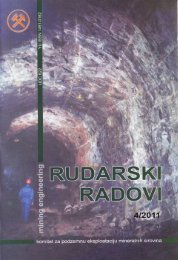Institut za rudarstvo i metalurgiju Bor
Institut za rudarstvo i metalurgiju Bor
Institut za rudarstvo i metalurgiju Bor
You also want an ePaper? Increase the reach of your titles
YUMPU automatically turns print PDFs into web optimized ePapers that Google loves.
GEOLOGY COMPOSITION AND<br />
TECTONIC SYSTEM OF THE<br />
WIDER SURROUNDING OF<br />
BANJSKA<br />
When describing mapping units allocated<br />
to Rogozna, special attention is given<br />
to those units that are important for leadzinc<br />
mineraliztion. These are the creations<br />
multi phase tertiary magmatism. Pre Tertiarry<br />
structures can be grouped as<br />
lithostratigraphic units: metamorphite Paleozoic,<br />
and permo-Triassic creation, Diabase-hornstone<br />
formations ultra-basic rocks<br />
and Senonian sediments.<br />
The data on these units were collected<br />
from the literature. Most of the interpreters<br />
used basic geological map sheet Novi Pa<strong>za</strong>r<br />
1:100 000 [12].<br />
Metamorphite Paleozoic structures include<br />
Old Paleozoic (so-called „series<br />
Rogozna”) and Late Paleozoic Metamorphite.<br />
The series Rogozna is present by<br />
amphibole, amphibolite, muscovite and<br />
sericite-chlorite schists, quartzite, crystalline<br />
limestone, metamorphosed diabase,<br />
gneiss, lepidolite and biotite shale. Metamorphite<br />
of Late Paleozoic rocks are represented<br />
by a lower degree of metamorphism:<br />
phyllite, metamorphosed sandstone, limestone<br />
and albite-chlorite shale. Permo-<br />
Triassis creations are discordance over Late<br />
Paleozoic metamorphite and are consisted<br />
by clastic, mainly quartz sandstones, quartz<br />
conglomerates and breccias, in a characteristic<br />
rapid removal. Lower and Middle Triassic<br />
of Banjska river are consisted by<br />
marled-sandy, marled and massive limestone.<br />
Age of the diabase-hornstone formation<br />
was determined as Upper Jurassic (Oxford-Kimmeridgian).<br />
Magmatites are presented<br />
by the products of Gabbro magma:<br />
Diabase, spilite, basalt, Gabbro and various<br />
transitional rocks. Since the sediments are<br />
represented by breccias, sandstones often,<br />
slates, hornstone, marl, marled limestone<br />
and clay shale. The complex consists of<br />
ultrabasic rocks harzburgite, much less<br />
share a dunite, diallage and serpentinite. By<br />
the opinion of M. Urosevic and others.<br />
(1973) these rocks represent the products of<br />
initial magmatism of Paleozoic Geosyncline.<br />
Under the new understanding, these rocks<br />
are of Jurassic period. In base of Senonian<br />
flysch sediments there are mostly basal<br />
breccias and conglomerates, massive reef<br />
limestone, marled limestone and marl where<br />
real flysch sediments were developed which<br />
can be divided in two packages. Lower<br />
package is characterized bythe marled-sandy<br />
sediments with rare micro-conglomerates.<br />
The upper package is presented by sandstone<br />
stratified in thick beds, up to ten meters.<br />
Between the sandstone banks there are<br />
periodically thin layers of slates, Marl and<br />
pelite-morphite limestone.<br />
During the Tertiary Rogozna is affected<br />
by intense igneous activity, which took<br />
place in three clearly divided phases. According<br />
to the mineral composition of volcanic<br />
rocks of the first phase correspond<br />
mainly to dacite-andesite. Only a few of<br />
them are typical dacite and quartzlatite.<br />
Pyroclastic rocks have little distribution,<br />
and they are volcanic conglomerates, tuffs<br />
and volcanic pelite . Volcanic rocks of the<br />
second phase are presented by quartzlatite<br />
and latite. Quartzlatite masses are mostly<br />
filled holes of volcano or volcano feeder<br />
channels, or a shallow intrusion of wired or<br />
irregular shapes. The second phase of volcanic<br />
pyroclastic rocks are with characteristic<br />
composition: tuffs, tuffite and conglomerate<br />
rocks are in the lowest horizons, and<br />
higher packages, which are very thick (350<br />
m) are characterized by volcanic conglomerates,<br />
tuffs, volcanic breccia in weaker or<br />
stronger fused pyroclastic rocks of ignimbrite<br />
character. Volcanic rocks of the third<br />
No 1,2010. 160<br />
MINING ENGINEERING



